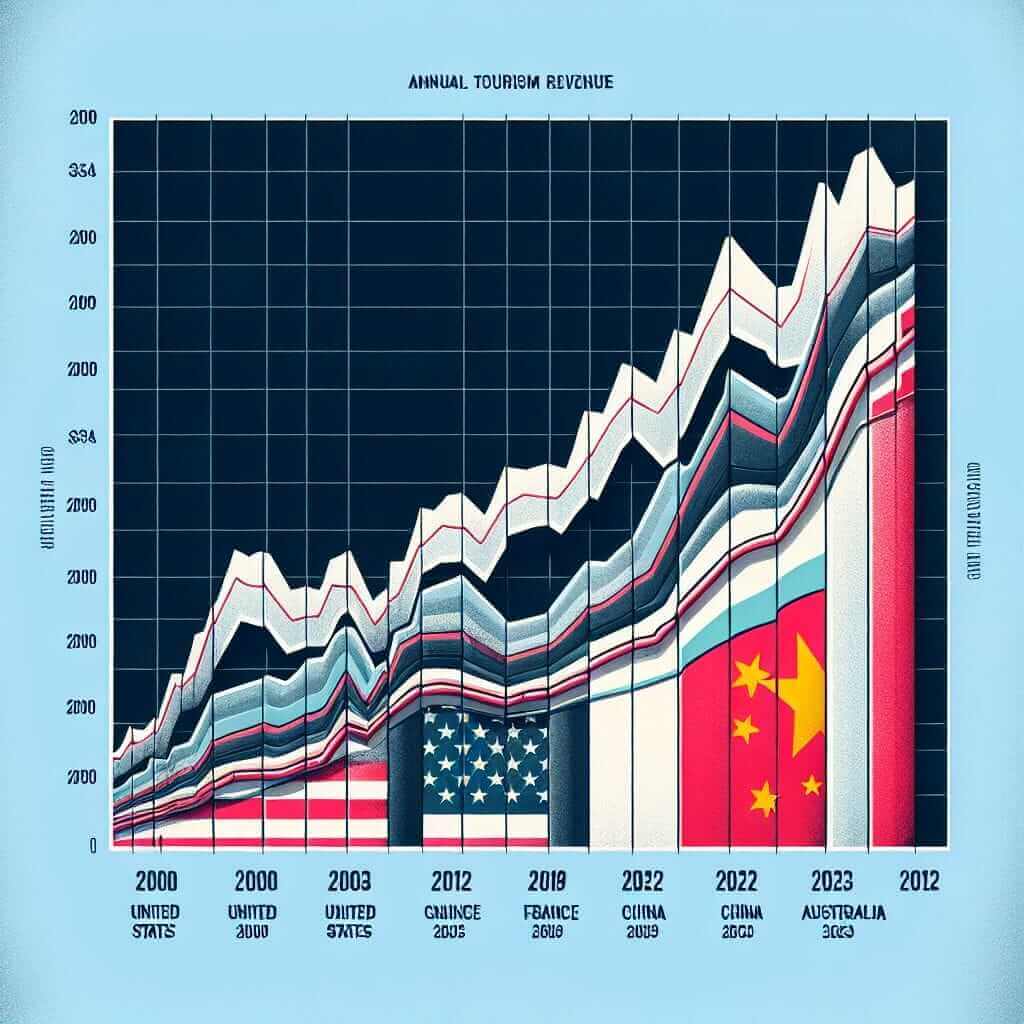Understanding the trends in tourism revenue across different countries can be a crucial part of writing an IELTS task 1 response. In this article, we will explore the key elements of writing a high-scoring IELTS task 1 essay on this topic, including vocabulary, grammar, and strategies.
Introduction
The topic “Annual Revenue from Tourism in Different Countries (2000-2023)” is a relevant and frequently discussed subject in IELTS writing task 1. Candidates are often asked to describe and compare data presented in various forms, such as bar charts, line graphs, tables, and pie charts. Here, we will generate three sample questions related to this topic:
- The line graph below shows the annual revenue from tourism in four different countries from 2000 to 2023. Summarize the information by selecting and reporting the main features and make comparisons where relevant.
- The bar chart below illustrates the tourism revenue in six different countries in 2000, 2010, and 2020. Summarize the information by selecting and reporting the main features and make comparisons where relevant.
- The table below provides information about the annual tourism revenue in five countries from 2000 to 2023. Summarize the information by selecting and reporting the main features and make comparisons where relevant.
For this discussion, we will focus on the first sample question.
Choosing a Topic and Creating a Chart
We’ll create a line graph to visually represent the data on annual tourism revenue in four countries – the USA, France, China, and Australia – from 2000 to 2023.
Line Graph
Figure 1: Annual Revenue from Tourism in Different Countries (2000-2023)
| Year | USA ($ billion) | France ($ billion) | China ($ billion) | Australia ($ billion) |
|---|---|---|---|---|
| 2000 | 150 | 100 | 80 | 70 |
| 2005 | 165 | 110 | 90 | 75 |
| 2010 | 180 | 130 | 120 | 80 |
| 2015 | 200 | 140 | 150 | 95 |
| 2020 | 210 | 135 | 160 | 100 |
| 2023 | 220 | 145 | 170 | 105 |

Analyzing the Task
Question Analysis
The question asks us to summarize and compare the annual revenue from tourism in four different countries over a period of time. Our primary goals are to:
- Identify the general trends.
- Highlight the most noteworthy data points.
- Make relevant comparisons between the countries.
Writing the Sample Essay
Introduction
The line graph presents the annual revenue generated from tourism in the USA, France, China, and Australia between 2000 and 2023.
Overview
Overall, all four countries experienced growth in their tourism revenue over this period. The USA consistently generated the highest revenue, while Australia had the lowest figures. China saw the most substantial growth.
Main Features and Comparisons
From 2000 to 2005, tourism revenue in the USA increased steadily from $150 billion to $165 billion. France and China also saw gradual increases to $110 billion and $90 billion, respectively. Meanwhile, Australia’s revenue grew modestly to $75 billion.
In 2010, the USA’s revenue reached $180 billion, maintaining its leading position. France’s revenue rose significantly to $130 billion, while China’s figures surged to $120 billion, overtaking France for the first time. During this period, Australia saw a moderate increase to $80 billion.
The trend continued in the same direction by 2015, with the USA’s revenue touching $200 billion. China continued its rapid ascent reaching $150 billion, surpassing France, which had $140 billion. Australia’s growth remained steady at $95 billion.
By 2020, the USA’s tourism revenue hit $210 billion, although France’s figures slightly declined to $135 billion. China continued its upward trajectory with revenue rising to $160 billion, and Australia reached $100 billion.
In 2023, the USA had the highest revenue at $220 billion, followed by China at $170 billion. France recorded $145 billion, and Australia trailed with $105 billion.
(Word count: 213)
Key Considerations for Writing
Vocabulary and Grammar
Key Vocabulary:
- Tourism (noun) [ˈtʊə.rɪ.zəm]: the commercial organization and operation of holidays and visits to places of interest.
- Revenue (noun) [ˈrɛvənjuː]: income, especially when of a company or organization and of a substantial nature.
- Gradual (adjective) [ˈɡrædʒuəl]: taking place or progressing slowly or by degrees.
- Substantial (adjective) [səbˈstænʃəl]: of considerable importance, size, or worth.
- Surge (noun) [sɜːdʒ]: a sudden powerful forward or upward movement.
Grammar Tips:
- Use the past simple tense to describe completed actions: “Revenue in France rose significantly.”
- Comparative structures are essential for making comparisons: “China had the most substantial growth.”
- Superlative forms to emphasize extremes: “The USA consistently generated the highest revenue.”
Important Notes:
- Ensure clarity and coherence in presenting data by summarizing and comparing.
- Vary your vocabulary to avoid repetition.
- Use appropriate tenses based on the data provided.
Conclusion
Writing an effective IELTS task 1 response involves identifying significant trends, comparisons, and utilizing the right vocabulary and grammar. By following these steps and focusing on the essential elements, candidates can aim for Band 7+ in their IELTS writing task.